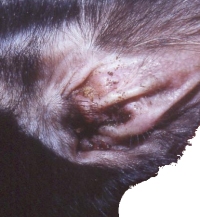Ear mites
Ear mites are the most common ear infection in cats. Although there a number of mite species which can cause ear infection, the most common invasive species is Otodectes cynotis. These tiny ear mites live in the ear canal of the catís ear and feed on the epidermal debris and ear wax. However, contrary to common belief, ear mites can also infect other sites of the body, most commonly the neck and the tail (It is a close relative of this mite which causes mange in dogs). So it is important to treat not only the ear for an infection but also the catís skin in general to prevent re-infection. |
Symptoms and diagnosis of ear mite infection
Some cats may be asymptomatic (i.e. show no signs that anything is wrong). But for most cats, an infection by mites will be irritating and itchy, so the first sign you will notice is your cat scratching her ears. Sometimes she will shake her head as well. If the itching is severe, a cat will scratch the ear so hard that it will actually cause bleeding. This may in turn set off a secondary bacterial infection. Once the ear becomes painful you will notice that the cat will prefer to keep the infected ear flattened or laid back.

Ear mite infection can be easily seen with a naked eye. With more advanced infestations, the ear canals will bleed and either fresh or dried blood will be visible inside the canal. (Dried blood resembles coffee grounds.) The build-up of dark granular material can be easily seen when looking into the catís ears with a flashlight. You might also see small whitish dots which are clumps of ear mites. This appearance is fairly indicative of a mite infection although a bacterial and/or yeast infection is also a possibility. The vet may take a swab from the infected ear and look under the microscope to confirm the diagnosis.
Treatment
Ear mites are very infectious and they can spread very quickly from animal to animal. This can be a serious problem in multi-pet households. Also if left untreated, an ear mite infection can, over time, lead to permanent damage of the ear canals and eardrums. In some cases this can result in permanent hearing loss.
Before starting anti-mite treatment it is important to clean the infected ear and remove the dried blood and debris. Then the ear should be treated with an appropriate medication to kill the mites. Your vet will tell you what to use. Never use any medication not approved for use in cats or you might do more harm than good. As a general rule a cat should be treated for at least two weeks after the mites have been killed.This is to catch the next generation of ear mites which are just about to complete their life-cycle (see the life-cycle described below). The vet may also advise repeating the treatment after three weeks.
As mentioned above, the ear mites can spread to other parts of your cat's skin. The most common secondary infection sites are the neck and the tail. Most good quality flea products will also kill ear mites so these can be used to eradicate any potential mites outside the ear. The bedding and any other places where the cat tends to spend time (sofas, carpets etc) should be also cleaned and treated with anti-flea products.
Prevention
Regular applications of Frontline (Fipronil) or Revolution (Selamectin) can reduce the risk of ear mite infection.
Life-cycle of an ear mite
The life-cycle of ear mites is in five stages. The cycle starts with eggs which are laid by a female adult mite. A typical female mite lays about 5 eggs every day for her entire adult life. The eggs hatch within four days , and this starts the second stage of the cycle - the larvae. Larvae feed on the cat for 3-5 days. Then they become dormant for 24 hours, during which time they mature to the nymph stage. As nymphs, the larvae turn first into protonymphs and then deutonumphs. Each stage takes about five days. After this they finally become fully mature mites.
Most medications kill these mature mites but not eggs or larvae. Thatís why it is important to medicate your cat for at least two weeks after the adult mites have been eradicated.
An untreated infection with ear mites may result in thousands of mites in the infected ear. The record number of ear mites found in a single cat's ear is 3,500.

